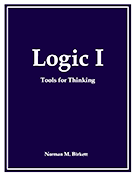 Logic I: Tools
Logic I: Tools
for Thinking
Student e-Book
Pdf download
|
Highlights
Logic I: Tools for Thinking is used as an introductory or second-year textbook for students in grades 8 or 9 and above (and some 7th graders), in homeschool, co-op, and Christian school settings. Logic I: Tools for Thinking covers a wide range of topics in both formal and informal logic accurately and engagingly. Humorous and serious examples are drawn from a wide range of subject areas: religion, history, politics, literature, science, taxes, and more. If you're looking for in-depth coverage at a sensible pace—with no logic background required—and you want a thoroughly Christian perspective on logic, then Logic I: Tools for Thinking is for you.
"A great introduction to both formal and informal logic. If someone took no other introductory logic course, this would be the one to take . . .
I would use Birkett's Logic again in a heartbeat."
Peter Lipsy, co-op teacher
More testimonials and an in-depth look at the curriculum are found at our Logic curriculum page.
Scope of Logic I: Tools for Thinking
Logic I begins with vital foundational topics: thinking and reasoning, what logic is, language and how it relates to logic.
The course then moves on to statements and logical operators, along with various tools to use on them. Topics include negation, contradiction, conjunction, disjunction, equivalence, and implication.
On this foundation one of the most useful modern formal (or deductive) logic systems, the sentential calculus, is developed in detail. Formal logic has broad application in such areas as mathematics and computer programming.
The book closes with a substantial section devoted to informal (or inductive) logic. Informal logic encompasses the types of arguments students encounter on a daily basis.
This combination of formal and informal logic topics makes Logic I: Tools for Thinking unusual in its breadth and usefulness. If you're looking for a substantial, year-long course which will strengthen your child's thinking skills (and stimulate yours too!), this course is for you.
"At the end of the course I was astounded by the number of arguments that could be understood and usefully evaluated using the tools in this one textbook."
—Peter Lipsy, co-op teacher
Guided tour with sample chapters
To read in more detail about the content of the program, and to view sample chapters, take the guided tour with sample chapters.
Frequently asked questions
When can my child begin?
Most students will be ready to begin Logic I: Tools for Thinking in grade 9 or 10, many in grade 8, and some in grade 7. For a fuller discussion, see the Logic curriculum page.
When will we finish Logic I: Tools for Thinking?
Logic I: Tools for Thinking contains a generous amount of material. It will take the typical student a year or slightly more
to complete, assuming three class periods per week (forty to forty-five minutes each).
What do I order?
If you will be schooling more than one child, order one student book for each child you are teaching, plus one student book, one teacher's manual, and one test pack for yourself.
If you will be schooling just one child and do not mind sharing the student book, then just order one teacher's manual and one student book, total. If you will be schooling just one child but want your own student book, then order one teacher's manual and two student books. (Note that the student book is not a workbook; all exercises are done on separate paper. So sharing the student book is possible even if you, too, wish to do all the exercises.)
Is there a discount for volume orders?
If you need more than fifteen copies, contact us for a discount.
Satisfaction guarantee
We stand behind our products with a 90-day unconditional guarantee; see our policies page for details.
Secure ordering
We use PayLoadz, fully integrated with PayPal, for safe and secure order processing. For details, see the policies page.
 |



